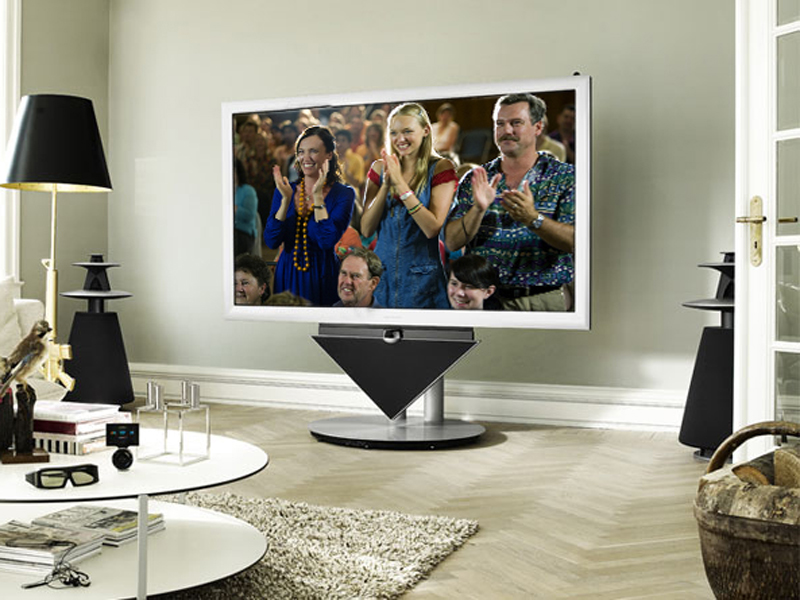Why you can trust TechRadar

Sound
If the picture relies largely on the Panasonic plasma panel it's hosted on, the sound is all Bang & Olufsen's work. The BeoLab 10 speaker that sits below the screen is a mono driver – but acts as a centre channel in a surround sound set-up, which is virtually the law if you're spending this much.
In our review the BeoVision 4-85 was paired with two BeoLab 5 speakers (£3,600 per pair) and two surround sound modules, the BeoLab 3 (£2,700 per pair). The sound is crystal clear and powerful, as it should be at this end of the market.
In fact, with the sharp and well-weighted vocals, pitch-perfect bass levels (no external subwoofer is needed) and overwhelmingly effective surround effects, we'd argue that the audio brings the movie to life just as much – if not more – than the 3D effects onscreen.
Value
If you want one of the best screens on the planet, it will cost you. There is the small matter of price to contented with though – Panasonic's TH-85VX200 costs a 'mere' £42,000, so where's the BeoVision 4-85's extra £24,000 going? On the robot arm, perhaps? The motorised stand?
The look of the BeoVision 4-85 is a lot more sculpted, and the way it integrates into a home automation system – and, more importantly, a speaker array – is impressive. Other than that, the money seems to get you a screen that delivers a consistent picture performance that refuses to bend to your will.
Sign up for breaking news, reviews, opinion, top tech deals, and more.
For those after a top-notch, fuss-free 85-inch screen with huge wow-factor, the BeoVision 4-85 is first class – but the only real reason for any TV to cost £66,000 is that a production line simply doesn't exist; it's custom-built, and that is what determines the price.
Ease of use
There are two remote controls to pick from. The default option is a Beo4, a long, slender and pleasingly weighty product that takes some getting used to. It's thoroughly effective, though a tad slow at communicating with an IR receiver that protrudes from the BeoVision 4-85's top right-hand corner. The Beo6, which has been in the Bang & Olufsen arsenal for quite some time, costs £230.
Those that want a more up-to-the-minute touchscreen remote are also catered for by the Beo6. It's a strange looking thing, with a small colour OLED screen sitting atop what looks like part of a model aircraft's fuselage. It's nicely weighted and comfy to hold, but best of all channel logos can be programmed to appear on the touchscreen.
At £600 it adds further to the increasingly stratospheric bill (it comes free with the BeoVision 4 and BeoVision 7 products, so why not this top-of-the-range TV?).
The remote really comes into its own when controlling external equipment; we managed to control the internal workings of a Sky+HD box with no problem, perusing the EPG and setting-up recordings.
Both remotes are capable of mastering a home automation system if paired with a MasterLink Gateway so, for example, you can use it in conjunction with a Lutron lighting system; press 'movie' on either Bang & Olufsen remote and the Blu-ray kicks-in as the lights dim. It also works with Crestron and AMX systems, so for the wealthy it can control security systems, ventilation, curtains, a burglar alarm – even your electronic pool cover.
The TV's user interface doesn't make such a splash, though it is complete simplicity defined. While other brands struggle to introduce polished graphics and colourful, responsive menus, here a different attitude has been taken. There is a bare-bones (and attractive, despite being just white text on a black background) interface that cuts in menus and choices from the left-hand side, but usually the remote can be used to directly choose the source.
Those wanting to control TV, or even entire zones of their automated house, with a smartphone can do so with the free – and highly polished – BeoLink app on iPhone or Android.
Current page: B and O BeoVision 4-85: Sound, value, use
Prev Page B and O BeoVision 4-85: Picture Next Page B and O BeoVision 4-85: Verdict
Jamie is a freelance tech, travel and space journalist based in the UK. He’s been writing regularly for Techradar since it was launched in 2008 and also writes regularly for Forbes, The Telegraph, the South China Morning Post, Sky & Telescope and the Sky At Night magazine as well as other Future titles T3, Digital Camera World, All About Space and Space.com. He also edits two of his own websites, TravGear.com and WhenIsTheNextEclipse.com that reflect his obsession with travel gear and solar eclipse travel. He is the author of A Stargazing Program For Beginners (Springer, 2015),
